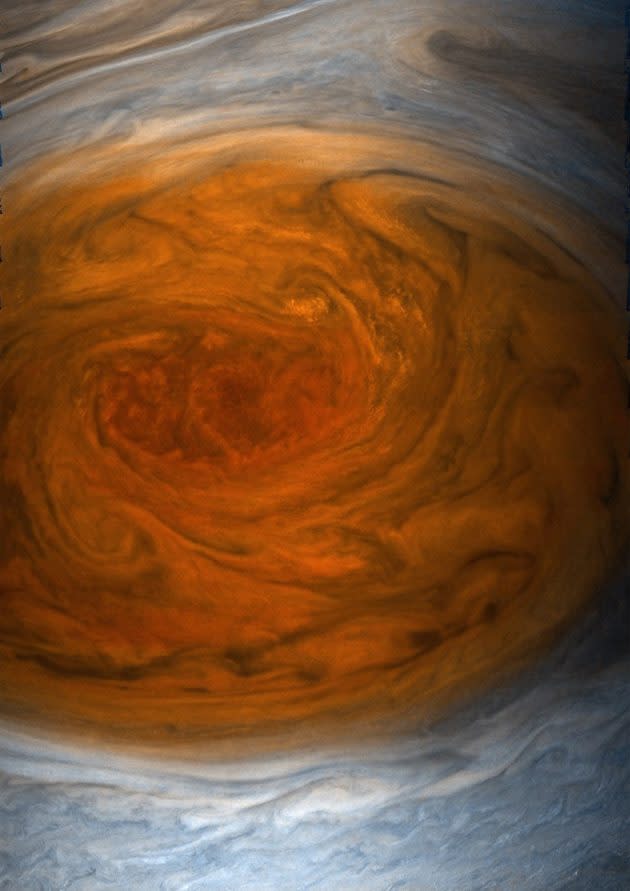By Jove! Juno orbiter snaps the greatest pictures of Jupiter’s Great Red Spot

The long-awaited close-ups of Jupiter’s Great Red Spot have arrived from NASA’s Juno orbiter, and they’re spectacular.
Juno has been orbiting the giant planet for more than a year, but last weekend’s flyby was the closest that the probe came to the solar system’s most famous superstorm. The JunoCam imager captured data from as little as 2,200 miles above the cloud tops, and the probe flew directly over the Great Red Spot at a distance of 5,600 miles.
It took a couple of days for the data to be transmitted and distributed, but today, image-processing wizards around the world got their chance to work their magic on the 10,000-mile-wide spot.
The results are flowing into JunoCam’s online database, from NASA and mission scientists as well as the general public. Here’s a sampling:
Spot spotted! #JunoCam raw images from my #Jupiter #GreatRedSpot flyby are available now. Download, process + share https://t.co/zx6fcc7Fzu pic.twitter.com/NJafDJVVW6
— NASA's Juno Mission (@NASAJuno) July 12, 2017
They're here! My first processed raw map-projected image of #Jupiter's Great Red Spot from @NASAJuno's P7 flyover on July 10-11 #GRSflyover pic.twitter.com/DpSYHA7IVt
— Jason Major (@JPMajor) July 12, 2017
Folks, it's #Jupiter's Great Red Spot from @NASAJuno Perijove 7!!!!!!! – https://t.co/nb5WAnLoBg pic.twitter.com/IugzWRzClq
— Kevin M. Gill (@kevinmgill) July 12, 2017
.@NASAJuno's early raw #Jupiter data (and Great Red Spot) turned into a gif https://t.co/Xgg2SDCuKQ [via Glitch Black] pic.twitter.com/FFZipuYRFn
— Massimo (@Rainmaker1973) July 12, 2017
My first processed raw image! ?@NASAJuno #Jupiter #GreatRedSpot (via PS Express)
-Marty #SolarSystemAmbassador pic.twitter.com/8c3F7couQl
— BackyardAstronomyGuy (@BackyrdAstroGuy) July 12, 2017
I’m seeing spots! Check out #Jupiter’s #GreatRedSpot in these stunning citizen scientist-processed #JunoCam images https://t.co/FWLvPvIG9h pic.twitter.com/ej2bI9NlDK
— NASA's Juno Mission (@NASAJuno) July 12, 2017
#DYK that once we get raw images of Jupiter’s #GreatRedSpot back from @NASAJuno, you can help process them?! Details https://t.co/3hmp4ZsHSY pic.twitter.com/4AqyTHLm8C
— NASA (@NASA) July 11, 2017
It’s true: Juno’s primary mission is to study Jupiter’s magnetic field and gravity field, with an eye toward figuring out what the planet is made of and how it was formed. JunoCam was included on the spacecraft primarily as a public outreach tool.
“The public is an essential part of our virtual team,” the Juno science team explained in a paper published during preparations for the mission. “Amateur astronomers will supply ground-based images for use in planning, the public will weigh in on which images to acquire, and the amateur image processing community will help process the data.”
You can expect more stunners as the community tweaks the settings for the raw imagery acquired during the latest pass, known as Perijove 7. And the planning has already begun for Perijove 8, set for Sept. 1. The close flybys are due to continue on a 53-day cycle until the mission’s end in 2018.

 Yahoo News
Yahoo News 